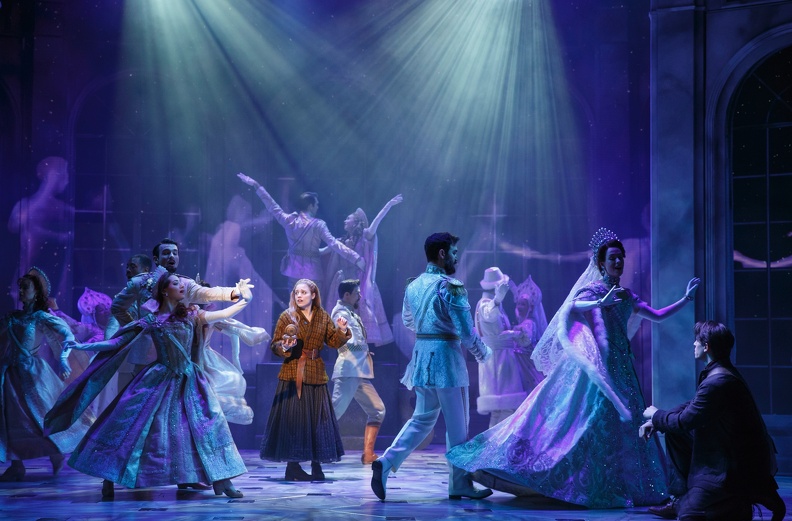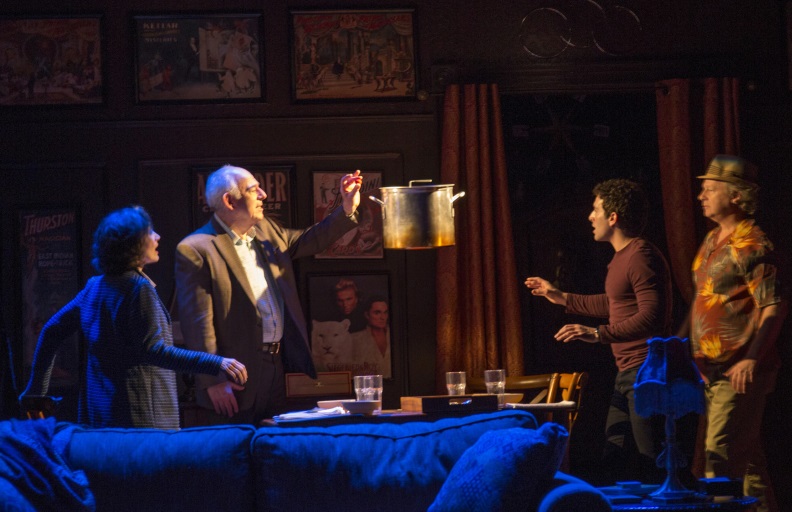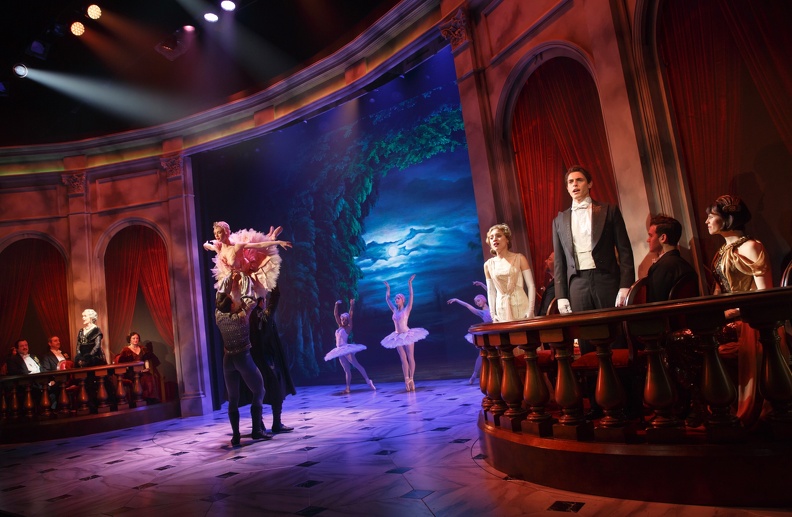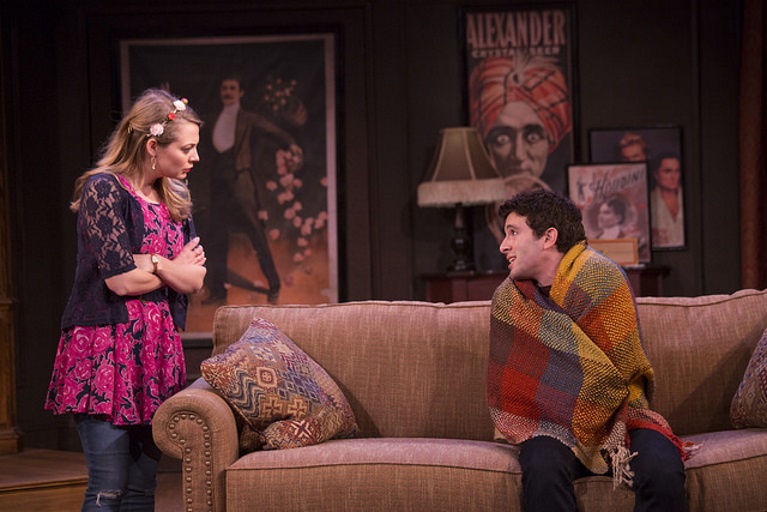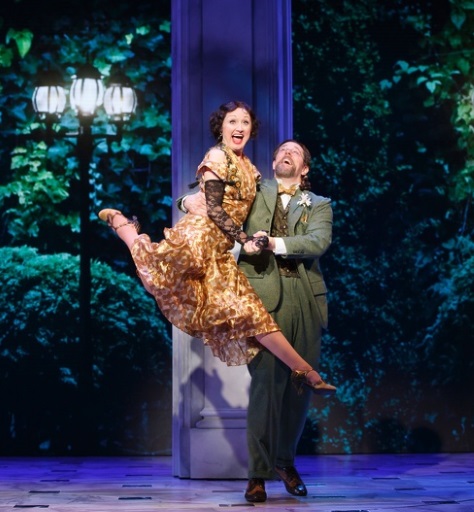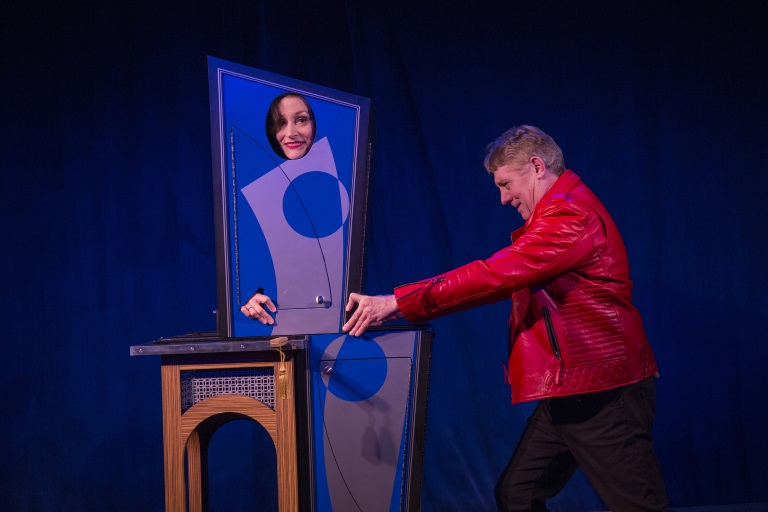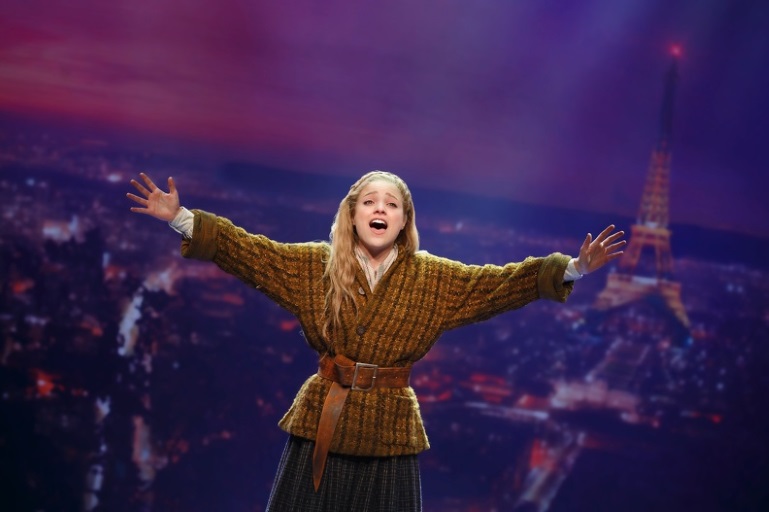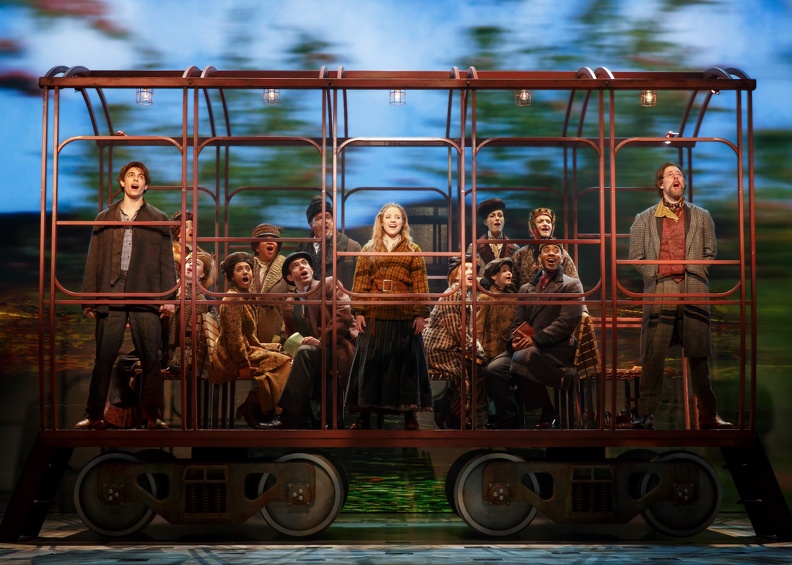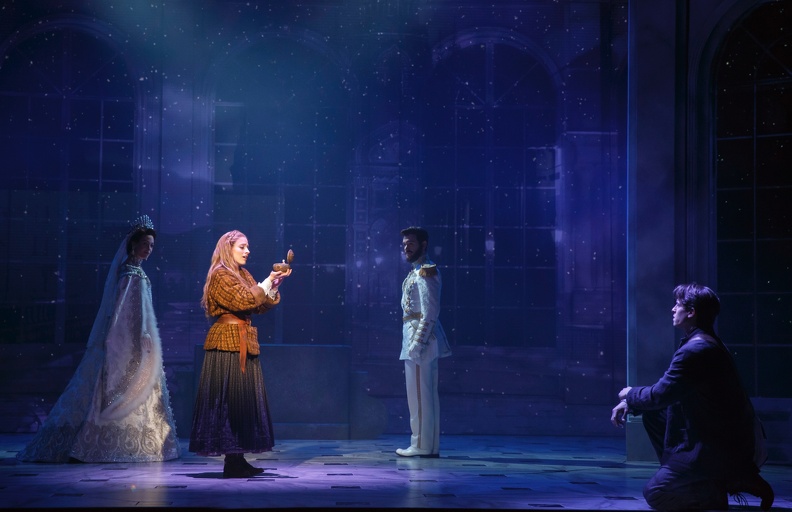Two world-premiere musicals have just opened in the region. One is an unassuming little pocket piece with a nifty hook, the other a glamorous spectacular that assumes it’s going to Broadway.
The Musical Theatre Lab at Barrington Stage has developed dozens of new works over the years, starting ten years ago with the now-famous 25th Annual Putnam County Spelling Bee. The latest from William Finn’s hothouse is Presto-Change-O, playing through June 11.
It’s essentially a family dramedy wrapped up in an tantalizing topic: magic. The family are three generations of performing magicians:  Elderly Sheldon (Lenny Wolpe) is starting to lose the balls in his signature disappearing-ball trick, and some of his marblesm too; his son Lance (Michael Rupert) is an ex-headliner planning a comeback after being sidelined when the secret behind his illusions was leaked; and Lance’s son Michael (Jarrod Spector), who did the leaking, has been blackballed by the profession, and his father, for breaking the magicians’ code.
Elderly Sheldon (Lenny Wolpe) is starting to lose the balls in his signature disappearing-ball trick, and some of his marblesm too; his son Lance (Michael Rupert) is an ex-headliner planning a comeback after being sidelined when the secret behind his illusions was leaked; and Lance’s son Michael (Jarrod Spector), who did the leaking, has been blackballed by the profession, and his father, for breaking the magicians’ code.
Lance’s ex-wife Mary (Barbara Walsh), who worked as his onstage assistant – we witness the sawing-in-half trick in a flashback – is an accomplished prestidigitator in her own right, and so is Lance’s secretary/gofer, Tina (Jenni Barber), who sees herself in the magician’s top hat and tails. There’s also Lance’s wheeler-dealer brother Arthur (Bob Walton), the only non-magician in the pack – and the only cast member who doesn’t do live onstage illusions.
The question that drives the piece is how to get these estranged family members back together again. Will it take more than a simple trick – like the cut-up pieces of string that in Sheldon’s hands magically reassemble into a single strand – or a “true illusion”?
The answer, it turns out, is both.
The show, with songs by Eric Price and Joel Waggoner, is all but sung-through, which is a good thing, since the spoken dialogue, also by Price, is simply functional, set within some pretty mechanical plotting. You probably won’t be humming any of the tunes as you leave the theater, but the songs are more than serviceable, neatly revealing character and carrying the plotline forward.
Most memorable to me was “If I Were Magic,” a musically deft flirtation between Michael and Tina. (Of course there’s a love interest – it’s a musical!) On Barrington’s intimate St. Germain Stage, though, backed a small, mostly acoustic combo, the cast is way overmiked, and some of the big, arms-outspread song finales are too Broadway-grandiose for the size of the space and the show itself.
For me, the most fun in the show is watching the magic tricks, most of them classic sleight-of-hand, and the fun the cast is clearly having with them. It’s a shame this tremendously likeable, talented and nimble-fingered ensemble is given a show that is so slight-of-material.
IS SHE OR ISN’T SHE?
My expectation of Anastasia, the sumptuous new musical now in its debut run at Hartford Stage (through June 19), was that it would be essentially a live-action version of the 1997 animated feature, in the mold of Beauty and the Beast and Aladdin. That must be what the audiences expect, too, as the run was all but sold out before it opened.
And indeed it is, with some grown-up adjustments, and the first-act curtain, a vision of Paris spread out below a hilltop, comes straight out of the animated tale.  It’s directed by Darko Tresnjak, who has brought back most of the creative team responsible for his Tony-winning A Gentleman’s Guide to Love and Murder, which also began life at Hartford Stage.
It’s directed by Darko Tresnjak, who has brought back most of the creative team responsible for his Tony-winning A Gentleman’s Guide to Love and Murder, which also began life at Hartford Stage.
The score, by Lynn Ahrens and Stephen Flaherty, is based on their songs for the film, with new numbers that fit in smoothly (but it’s still the old ones that you’ll be humming on the way home) and some adaptations of the originals for the more sophisticated theatergoing audience. “Paris Holds the Key to Your Heart” adds cameos by Left Bank luminaries of the ’20’s – Picasso and Hemingway, Josephine Baker and Coco Chanel – with a nice Gertrude Stein gag thrown in.
In case you haven’t seen the cartoon, or the 1956 Cinemascope film starring Ingrid Bergman and Yul Brynner (this version claims both movies as its basis), the story springs from the persistent rumor, in the wake of the Russian Revolution, that the Czar’s teenage daughter, Anastasia Nikolaevna, had escaped being executed with the rest of the Romanov family.
 In the Twenties several women appeared, claiming to be Anastasia, and the plot revolves around two resourceful fellows who decide that passing off an imposter as the royal princess can be their ticket out of the repressive “new Russia” and, not incidentally, into a portion of her unclaimed inheritance. They latch onto Anya, a young woman who bears a resemblance to Anastasia. She has suffered partial amnesia but has flashes of memory of a regal childhood.
In the Twenties several women appeared, claiming to be Anastasia, and the plot revolves around two resourceful fellows who decide that passing off an imposter as the royal princess can be their ticket out of the repressive “new Russia” and, not incidentally, into a portion of her unclaimed inheritance. They latch onto Anya, a young woman who bears a resemblance to Anastasia. She has suffered partial amnesia but has flashes of memory of a regal childhood.
Could she perhaps be the real thing?
The script, while hewing most closely to the animated film in tone and substance, is new, written by the playwright Terrence McNally. Anastasia reunites him with Ahrens and Flaherty, his collaborators on the musical Ragtime. This one stays firmly in the family-entertainment realm, though it does toughen up some of the animation’s soft center, including a nod toward the let-them-eat-cake attitude that contributed to the Romanovs’ demise. (It’s got the equivalent of a PG rating, “Recommended for ages 10+.”)
If you have seen the animated film, you’ll be relieved to know that no cute puppy-dog or other Disneyesque animals are to be found, and no diabolical nemesis in the form of the ghost of Rasputin. In fact, the danger element – in addition to the risk that Anya will be unmasked as a fraud – is provided by an all-new, dramatically effective character. He’s no cartoon villain but a conflicted Party official, torn between his duty to the state (to kill this pretender to the vanquished throne) and guilt over his father’s role as one of her family’s executioners.
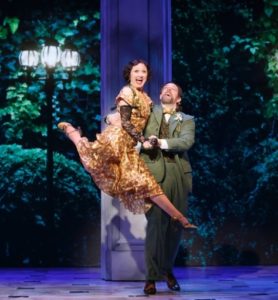 I was surprised to count only 19 actors in the curtain call, since so many of them act (and dance!) so many supporting roles so effectively. Among the leads, Derek Klena is lively and likeable as young Dmitry, half the pair of would-be con artists (and Anya’s love interest – of course). He is comically counterpointed by John Bolton, as the older and slyer Vlad, who in turn is amusingly complemented by Caroline O’Connor as the old flame who is their entrée to the old Dowager Empress – the surviving Romanoff whose imprimatur would validate Anya’s authenticity. Mary Beth Peil is suitably imperious in that role, though her saccharine tone in the opening scene with six-year-old Anastasia at first seemed to validate my expectation that we were in for a life-size copy of the animation.
I was surprised to count only 19 actors in the curtain call, since so many of them act (and dance!) so many supporting roles so effectively. Among the leads, Derek Klena is lively and likeable as young Dmitry, half the pair of would-be con artists (and Anya’s love interest – of course). He is comically counterpointed by John Bolton, as the older and slyer Vlad, who in turn is amusingly complemented by Caroline O’Connor as the old flame who is their entrée to the old Dowager Empress – the surviving Romanoff whose imprimatur would validate Anya’s authenticity. Mary Beth Peil is suitably imperious in that role, though her saccharine tone in the opening scene with six-year-old Anastasia at first seemed to validate my expectation that we were in for a life-size copy of the animation.
But this Anastasia is a bit grittier and more complex, and so is the title character, who gives better than she gets in a brawl with street hoodlums. Plus, seeing real humans adds some, well, humanity to the piece. But in the lead role, Christy Altomare is disappointing. Though she’s plenty fiery and passionate, she fails to really command the stage and her singing voice, a sturdy legit soprano, is too generic and often harsh.
For me, the real star of the show is Aaron Rhyne, the video genius who created the stage-wide animated projections that take us from season to season and, most thrillingly, from St. Petersburg to Paris via a high-speed helter-skelter train journey.
As I said, Anastasia clearly has its sights on New York – from its opulent production values to its poster-ready logo. Unlike Gentleman’s Guide, the show doesn’t break any new musical-theater ground. But I won’t be at all surprised if it runs for years.
Anastasia photos by Joan Marcus
Presto-Change-O photos courtesy Barrington Stage Company
If you’d like to be notified of future posts, email StageStruck@crocker.com

